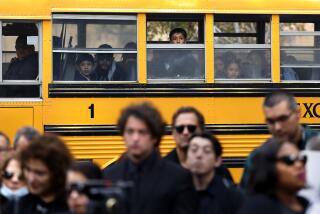Goth teens are more prone to be depressed or hurt themselves, study shows
This just in: 15-year-olds who dress exclusively in black, pierce themselves extensively and favor adornments that are ripped, spiky, raunchy or just-plain disturbing may be communicating that they are in psychological pain.
Adults can be a little slow on the uptake when it comes to reading an adolescent’s state of mind. But new research from the United Kingdom is here to help: By the time they were 18, Britons who self-identified as “goth” at the age of 15 were three times more likely to be clinically depressed and five times more likely to cut, burn or intentionally inflict injury on themselves than were young people who did not identify with goth subculture.
Published Thursday in the journal Lancet Psychiatry, the new research set out to plumb the mental health implications of group identity in British teens. While most British cliques have their American counterparts (jocks, nerds and popular kids), some were a bit harder to translate.
Of all the teen subcultures identified, goths fared most poorly, falling into depression by age 18 at roughly twice the rate as kids who identified as “skaters” or as “loners.” Teens who called themselves “sporty” were least likely to be depressed at age 18 (4%), or to engage in self-harming behavior (6%).
It would be wrong to conclude from this finding that identifying with kids who sometimes describe themselves as “emo” actually induces depression or prompts self-injury, the authors of the new research cautioned. Psychic contagion within teen groups is common enough. But psychological contagion is unlikely to explain why self-harm — thought to be a coping behavior for some with emotional pain — is so prevalent among such teens, they added.
Rather, the authors of the new research suggested, adolescents who feel alienated, bullied, marginalized or unhappy may be drawn to identify themselves with a social group that defines itself by its defiance of social norms.
Indeed, the detailed tallies of the new research suggests that a “birds of a feather” dynamic may draw together teens who show strong risk factors for depression from an early age.
In a cohort of 5,357 British kids followed from birth to at least 16, adolescents were asked before their 16th birthday what social group or groups they most identified with. Aside from goths, respondents could align themselves with the following youth subcultures: sporty, populars, skaters, chavs, loners, keeners or bimbos.
(I’ll save you some trouble here: The Urban dictionary identifies a “keener” as a nerd or smarty-pants who enthusiastically participates in pro-social activities. The online Cambridge dictionary defines “chav” as a pejorative reference to a young person whose dress, behavior or manner of speech demonstrates his or her lack of education or low social class.)
Some 12% of these young teens said they strongly identified with goth subculture, and the remaining 88% reported a low identification with goths.
Parental social class, maternal education, whether a child was shy, friendly or inclined to misbehave — none of these factors seemed to differentiate the teen who would identify as goth from the one who didn’t.
But goth teens were much more likely than those who did not identify as goth to have a mother with a history of severe depression, to report at 8 and again at 13 that they had been bullied, and to have ranked in the top quartile of 6-year-olds in “emotionality.”
By 15, more than a quarter of those who reported they identified “very much” as goth were already engaging in self-harming behaviors, compared with 10% of those who did not identify as goth at all. And the goth teens showed more depressive symptoms, on average, than did those who identified more with other groups.
By the time the study’s core group of 2,351 participants turned 18, 18% of those who had identified “very much” with goth subculture met the diagnostic criteria for depression, and 37% reported they engaged in self-injury. Among those who reported at 15 they did not identify with goth subculture, 6% were depressed and 10% had intentionally inflicted injury on themselves.
The effect scaled upward with the extent to which a 15-year-old had aligned with goth subculture. So even feeling “a little” goth was associated with increased risk of depression and self-harm.
“Working with youths in the goth community to identify those at risk of depression and self-harm and provide support might be effective,” the authors wrote. “Public campaigns to reduce stigma and aggression targeted to individuals from diverse subcultures might also be important.”
Follow me on Twitter @LATMelissaHealy and “like” Los Angeles Times Science & Health on Facebook.







